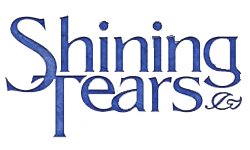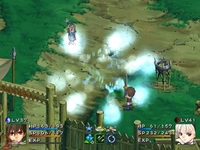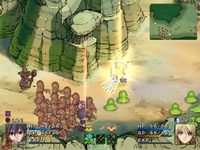|
|

|
PLATFORM
|
PS2
|
BATTLE SYSTEM
|

|
INTERACTION
|

|
ORIGINALITY
|

|
STORY
|

|
MUSIC & SOUND
|

|
VISUALS
|

|
CHALLENGE
|
Easy
|
COMPLETION TIME
|
20-40 Hours
|
|
OVERALL

|
+ Varied missions
+ Kind approach to death
- Time-consuming, uninteresting story
- Finicky AI
- Load times and slowdown
- Aggravating inventory
|
Click here for scoring definitions
|
|
|
After the debacles that were the Shining Soul games, Sega tried going back to the tactical model with Shining Force: Resurrection of the Dark Dragon. I bought that game as soon as I possibly could, but not enough people did likewise to justify further effort from Sega in that vein. Instead the series was handed to Nex Entertainment for another action RPG interpretation, this time on console. Apparently enough people bought Shining Tears to convince Sega that this was the appropriate direction in which to steer its revival of the franchise. As inexplicable mass decisions of 2005 go, this was one of the biggest, even counting the money Tim Story's Fantastic Four grossed.
Shining Tears is clearly a descendant of the Shining Soul games, featuring a player character hacking through thousands of enemies in real time by the end. This core idea has spawned plenty of worthy action RPGs over the years, and Shining Tears in short bursts works adequately at providing entertaining bouts, particularly with the interesting idea of having each enemy group suffer adversely if its leader is slain. Spending a little longer with the game will demonstrate that it could use a speed increase, as trudging back and forth with the only sprint option sending the character into an uncontrolled and temporary dash is not optimal. At least a good range of skills are available to learn at the player's choice with each level gained, and they make a sizable difference in how to approach combat. As a game in which getting killed is easy thanks to no recovery time between injuries, the potential modifications skills enable are very useful.
Some of the tears in the title doubtless come from the allies who accompany the player on every mission. The protagonist must always take one along when going into combat, and without a friend to control the partner, the game's AI is responsible for the ally's actions except in the rare instances when using the right analog stick to guide a second character's movement is not too much for the player to do. This means numerous moments in which the computer decides not to assist in the engagement taking place in its peripheral vision, along with numerous instances of an ally charging a group of enemies that had not yet entered the fray. The enemy AI isn't much better, showcasing foes who appear to be unable to sense events taking place in the same room, but as it prevents the player being swarmed at all times this is a useful thing. Keeping boneheaded allies alive is sometimes quite challenging, but letting one fall in battle can prevent the player from finding optional content only accessible by having a good relationship. They also enable link attacks that can be very useful, so increasing the player's stress by looking out for them is necessary.
Overhead sprite-based graphics on the PS2 should not be difficult to achieve, yet Shining Tears has serious issues nevertheless. The most prevalent is its load times, which occur before every mission and usually during them. The load times are long enough that keeping some reading material handy, a couple of paragraphs' worth for each instance, is a good idea. Tears also has a problem with slowdown, which will happen if enough sprites get onto the screen, and serves no helpful purpose like it once did for space shooters. The slowdown gets egregious in the last mission, where the player must assault enemy generators with fresh enemy sprites constantly appearing, a task that seems beyond either the PS2's capabilities or the developer's quality assurance standard. At least the visuals look fine once they appear, though distinguishing the preferred targets can be difficult when numerous small sprites are jammed into one location on the screen. Nex Entertainment had an inexplicable fondness for structures that block part of the screen, which in an action RPG often means enemies hiding underneath foreground objects and making sport of the player's efforts to find them.
 Neige survived long enough to pull off a link attack! She likes to get killed quickly, so that's noteworthy.
Neige survived long enough to pull off a link attack! She likes to get killed quickly, so that's noteworthy.
|
|
Shining Tears' inventory management is a curse in disguise. At first, the ability to assign three statistic points with each level gained seems ideal. What the game wastes no time in forcing the player to deal with is the requirement of almost all equipment to have certain statistics in order to let a character put it on. For the lead male this is annoying, as the requirements sometimes force many levels to be gained before a good piece of armor can be equipped. For his companions this gets even more idiotic, since making a mage's strength go up by a sizable amount is counterintuitive and otherwise useless. Managing items in combat is not joyous either, requiring the player to access the main menu to switch between the four different categories of usable inventory, only to then cycle through each categorization with the D-pad. Using the D-pad for this purpose also means that it is unavailable for moving the characters around, and using the analog stick for moving sprites on a 2D background feels odd. At least items take effect immediately and are clearly explained in the text.
The music found in Tears is varied and pleasant for the most part, making for an entertaining aural journey. The soundtrack keeps new tunes coming throughout the game, helping to keep it from becoming repetitive. The little voice acting on display is a different story, mostly because characters have a very small number of stock lines that the player will get to hear several thousand times in battle. During the narrative no voice acting is employed, making its appearances during visits to shops and battle rather jarring, even though the lines themselves aren't done in a terrible fashion. It didn't need to be that way when the Japanese version had voices consistently throughout the plot segments, but Sega apparently decided to cut costs.
The story itself is not a reason to play Shining Tears. Its beginning finds a young man named Xion washed up on a beach he does not recognize, with the slight problem that he has amnesia. After some assistance from an unexpectedly kind Elven woman named Elwyn, he displays a magical ring that produces a twin in the hand of whoever partners with Xion in battle. The rings transform Xion and his partner into dervishes dealing death everywhere it is needed, and an invasion by the Rune Geist army ensures that combat aptitude will be at a premium. Xion putting on his ring when with a partner seems to drastically alter his personality, but this intriguing element is underused and pretty much forgotten as the tale progresses. Otherwise Tears finds a number of protagonists gathering to combat the oncoming hordes, with some of them getting character details revealed later that fail to make a substantial difference to their underdeveloped personalities.
Without Xion's personality alteration, Shining Tears is using a no-frills version of the amnesiac hero plot device that was played out years before, though at least his identity crisis eats up relatively little screen time. The invading horde is less easy to excuse, since large chunks of the game focus on the small band of protagonists going head-to-head with an army of at least 10,000 and slaughtering soldiers by the hundreds. The narrative steadfastly refuses to acknowledge that, when two people have killed over 300 troops, the frequent mentions of how outnumbered the protagonists are cease to be meaningful. The climax of the game trots out an ancient evil that is getting ready to reawaken, another trick from the standard RPG story grab bag that is only notable because it somehow spurs forces who are trying to put down the badness into fighting with the protagonists.
 I don't think it's actually possible to have a level 1 Xion at this point in the game. Even if it was, WHY???
I don't think it's actually possible to have a level 1 Xion at this point in the game. Even if it was, WHY???
|
|
At least Shining Tears does a good job providing variety in its missions. Killing everything is often recommended, but actually not mandatory for many missions. The environments change enough to keep the game from feeling too repetitive when marching around its maps, and boss encounters at least feel distinct even if some of their attacks cannot reliably be dodged.
Considering how easy it can be to die, Shining Tears could have been an amazingly frustrating title. The only consequence is being booted back to the headquarters though, with items remaining on the field and slain enemies staying that way should the player choose to return. As it is entirely possible to be killed if a lucky magical shot is of the right element to rip the player apart, not losing progress in the lengthy later missions is most considerate. Diving straight through the game is somewhere around thirty hours anyway, a number that does not need to be adjusted upward thanks to the forgiving death mechanic.
If Shining Tears is remembered at all fondly, it seems to be for its second player feature. I did not use this feature, and as a result have almost no positive experiences with the title to impart. The character designs are nice, but the personalities they convey aren't worth spending time around. The game itself has plenty of technical issues and its AI will cause profanity to issue forth from player mouths. I went into this hoping against hope that Sega's third experiment with a Shining action RPG in the post-Camelot age would be worthy. All it accomplished was making me leery of Nex Entertainment for the rest of my life while cursing Sega yet again.
Review Archives
|









